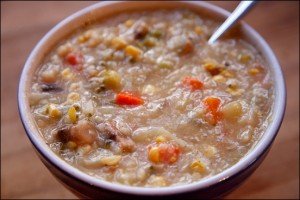Winter: The Season for Contemplation and Restoration
by Ellasara Kling
The Winter Season is ruled by the Kidney-Urinary Bladder organ system and is usually referred to as Kidney Season. During this season we strive to nourish the Kidney function. Let’s look at some of the relationships of this season and then how we can nourish the Kidney function. Please refer to the chart below as we do so.
 In TCM Five Element Theory the Kidneys are the place where our “essential qi” (jing) is stored. This essential qi is akin to the principal of a trust fund that we inherit from our biological parents. The vitality that we gain from this essential qi is the basis of our embryonic and fetal development. Once born, essential qi continues to affect various aspects of our physiology and to be the prime support for our growth. Two important and readily understood physiological aspects are healthy, strong bones (and bone marrow); how the Kidney function supports hearing through its connection with the ears. Perhaps an easy way to see this function is by what we know about aging in general. Generally speaking, as people age and use up their essential qi, commonly acknowledged signs of aging begin to appear: hearing loss and weaker bones. Fortunately, essential qi is not our only source of vital qi. The other is known as “acquired qi” and comes from the food we eat, the air we breathe and from qi cultivation in our energy practice, such as qigong.
In TCM Five Element Theory the Kidneys are the place where our “essential qi” (jing) is stored. This essential qi is akin to the principal of a trust fund that we inherit from our biological parents. The vitality that we gain from this essential qi is the basis of our embryonic and fetal development. Once born, essential qi continues to affect various aspects of our physiology and to be the prime support for our growth. Two important and readily understood physiological aspects are healthy, strong bones (and bone marrow); how the Kidney function supports hearing through its connection with the ears. Perhaps an easy way to see this function is by what we know about aging in general. Generally speaking, as people age and use up their essential qi, commonly acknowledged signs of aging begin to appear: hearing loss and weaker bones. Fortunately, essential qi is not our only source of vital qi. The other is known as “acquired qi” and comes from the food we eat, the air we breathe and from qi cultivation in our energy practice, such as qigong.
However, like a trust fund, we do not want to use up the principal. We want to preserve the principal and add to it, if possible. At all times, but especially during Winter we have opportunities to preserve our essential qi. We do this through following the flow of nature. In Winter the energy of the earth is drawn downward and inward. The barren trees and land, the early setting of the sun, the cold essence and temperatures all signify a world at rest. The seeming barrenness of the time is an opportunity to gather strength. This rest leads to restoration when Spring begins. And Spring actually begins long before we see its outcroppings. For us, Winter is also an opportunity for greater contemplation, quieter inner reflection, and more energy practice.
What can we do to preserve our essential qi in Winter?
Everyone has a different reaction to each season. Some people love summertime and the warmth it brings and a more outdoors lifestyle — others not so much. Whereas the cold of Winter usually inspires people to snuggle in the warmth of their home with a warm bowl of soup, hot chocolate or cup of tea. Other folks want to be out on the ski slopes or frozen lakes, skating, ice fishing, or even wind surfing. Each person’s preference is fine just keep in mind the basic guidelines for the season and don’t over exert yourself and be sure to get enough rest. Even if you cannot go to bed earlier, do your best to get extra rest during the day. Even when the temperature may be warmer on a particular day during this time of year, stay covered up. The essence of the season is cold and it is good to remember that, when planning your wardrobe. A hat, hood or scarf can be excellent choices. Additionally, eating foods such as soups, congees, hearty stews and warming drinks are excellent choices for the season. Still, do not over eat and thereby tax your digestive system. Eat only until you are 70-80% full. Recall, that a simple way to gauge that is to only eat until you are no longer hungry. Winter season foods are generally denser in nature, such as root vegetables, which are more filling. Even greens such as cabbages and Kale are denser than summer greens. Below is a list of some of the foods that are in harmony with this season. If you are not already familiar with them, try adding them to your diet. Seek out the foods which are natural to your locality in winter and that have not been shipped in from far away. It is already externally cold, refrain from eating cold and cooling foods such as iced drinks, and raw foods. Remember, the stomach likes warmth. Practice your Qigong or tai chi and meditate more. These seemingly simple ideas can go a long way in supporting your health throughout this season and help you to enjoy good health in the Spring.
Some Foods That Are Particularly Good For the Winter Season:
black beans, black mushrooms, blackberry, black sesame seeds and oil, black soybeans, blueberry, bone marrow, cabbages, celery, chard, chestnuts, cranberry, ginger, Job’s tears, kale, kidney beans, kohlrabi, Longan, Lotus seed, miso, mulberry, mutton, Ocean Perch, parsley, pine nuts, prunes, raspberry, rutabaga, seaweed, shrimp/prawns, soy sauce, string beans, turnips, walnuts, wood ear mushrooms.
Recipes for Winter
 Winter Congee
Winter Congee
Ingredients:
1/2 cup glutinous white rice about 1/4 cup each: pearly barley, small red beans, lotus seeds, boiled peanuts 2 TB size piece of astragalus also called huang qi and yellow vetch* 15 or so dried Chestnuts about 15 cups of water 15 or so red dates pinch of salt sugar or honeyDirections:
After rinsing/washing and then draining your grains, add them to a heavy bottomed pot with the water, bring to a boil and then reduce heat to a simmer and cover
Stir lightly and allow to simmer for about 20 minutes, then add the chestnuts and astragalus, stir lightly and simmer for another 20 minutes
Stir lightly and add the red dates and simmer for 15 minutes and then add the peanuts and sweetener to taste.
When cooking is complete remove the piece of astragalus before serving.
*known by a variety of names, Astragalus/Huang qi/Yellow Vetch has long been used in many cultures as an immune booster in home cooking and in herbal remedies.
 Black Rice Dessert
Black Rice Dessert
Ingredients:
1 cup black rice 1-1/2 cups coconut milk 2 cups water 25-30 red dates 1″ ginger root – peeled and sliced as if it were a fan so that it stays in one piece 1/4 cup wolfberries also called goji berries 3 TB toasted black sesame seeds coconut sauce – optional 1-1/2 cups coconut milk sugar or honey cinnamon – optionalDirections:
In a 3 quart pot, add the black rice and ginger root to the coconut milk and water, bring to a boil, reduce heat, stir lightly
Add the red dates, cover and simmer for about 20 minutes — check occasionally — you want the liquid to be completely absorbed – 1 cup of rice will provide about 3 cups of cooked rice
While the rice is cooking, boil 1 cup of water and pour it over the wolfberries. . as they rehydrate, pick out any stems or other material and then strain out the liquid
Toast your black sesame seeds in the oven for about 10 min. at 350 degrees F. then pour them into a large round bottomed bowl
When the rice is done add it to the bowl with the sesame seeds and stir them into the rice, then add the strained wolfberries. Rehydrated wolfberries are easily smashed so treat them gently.
Lightly flatten the top of rice mixture in the bowl and place a large plate over the top of the bowl, turn over quickly and gently remove the bowl, you will now have a beautiful spherical shape.
Optional sauce: Reduce the coconut milk and sweetener until it thickens, pour over rice sphere, sprinkle with cinnamon if you wish.
 Ethiopian Inspired Vegetables
Ethiopian Inspired Vegetables
Ingredients:
1/4 cup grapeseed oil 1/2 minced onion 1 TB minced fresh ginger 1/2 tsp salt 1/4 tsp ground black pepper 2 small red chili peppers (sometimes called birds eye peppers) 2 cloves of garlic – minced 2 stalks celery – chopped 3 medium potatoes – cut into 1″ cubes 1 cup water or broth 1 head cabbage cut into large wedges 2 carrots cut into 1″ piecesDirections:
In a wok or heavy skillet heat the oil and add the onion, ginger, salt, black and red pepper, garlic and heat through, then
add the celery and saute till it begins to sweat, add the water/broth and potatoes, cover and cook on medium heat for about 5 minutes
Add the cabbage and carrots and cook until tender. . .add more water or broth if necessary. Stir the ingredients together thoroughly so that the spices are distributed evenly. Remove the 2 small chili peppers. and serve.
This is a warming, hearty dish that is not too spicy but is very flavorful. Winter flavoring should be warming but not hot and spicy. Please adjust to your taste.
 Kale and Black Beans
Kale and Black Beans
Ingredients:
3 TB grapeseed oil 5-7 cloves of garlic – sliced 5-6 scallion whites – sliced into thin rings 1 tsp salt 1/2 tsp ground black pepper 1 bunch Kale – well rinsed and cut into ribbon strips 1/2 cup to 1 cup water or broth 1-1/2 cups cooked black beansDirections:
Heat a wok or heavy skillet and add the grapeseed oil, garlic, scallion whites, salt and pepper and heat through till the oil shimmers.
Add the Kale (remember to remove the tough part of the stems on each leaf) with 1/2 cup of water/broth, cover and simmer for 5 minutes
Add the cooked black beans and toss lightly. Heat thoroughly and serve.
Optional: a little sprinkle of black or balsamic vinegar at the end prior to serving.
Remember to smile at all things.
 Following the threads of her personal tapestry, Ellasara, a long-time student of Master Nan Lu, weaves her life around the exploration and sharing of self-healing through a variety of modalities, primarily focusing on food, common herbal plants, Qigong Meridian Therapy and Qigong for Women’s Health. For comments, questions, consultations, ellasara00@gmail.com
Following the threads of her personal tapestry, Ellasara, a long-time student of Master Nan Lu, weaves her life around the exploration and sharing of self-healing through a variety of modalities, primarily focusing on food, common herbal plants, Qigong Meridian Therapy and Qigong for Women’s Health. For comments, questions, consultations, ellasara00@gmail.com

